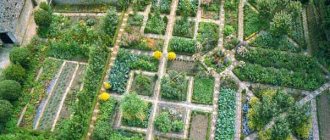How to choose colors harmoniously?
Roses of the same variety and color of petals in a flowerbed look good, but it is even better if the flowers are of different shades. To ensure that the composition is not too flashy, it is advisable to immediately think through the general concept of color. The following options are possible:
- Rose garden in pastel colors - pink, cream, white, lavender flowers.
- A flower garden that will not leave anyone indifferent - bright colors prevail in it, yellow, red, orange and purple stand out among them.
- A flower bed with bushes of two bright shades that contrast well with each other looks impressive. You can experiment and combine the following shades in one flower garden: white and red, yellow and purple.
- Another win-win option for combining colors in the garden is pastel, blurry tones of the main mass with bright splashes of individual bushes as accents. For example, a flower garden planted with roses in delicate shades, in which crimson, purple or orange flowers are occasionally found, will perfectly decorate a garden.
You can use roses in pastel colors as a basis.
What plant varieties are suitable for a rose garden?
The next step after allocating space for the rose garden and selecting flowers should be choosing a plant variety. Inexperienced gardeners make the mistake of purchasing flower seedlings that they like in appearance. The picture is not fully capable of displaying all the features of the plant. It is advisable to think in advance what type of roses will decorate the flower garden, having studied the properties and appearance of the flowers using photos and descriptions from reliable sources.
For those who have a small area allocated for a rose garden, it makes sense to try to use the available space as efficiently as possible. For small and cozy flower beds, miniature compact plant bushes are suitable.
Also, noble flowers look good in combination with other plants. It should be recognized that this option for planting roses is the most preferable. In the company of irises, carnations, catnip or lavender, roses will shine like precious stones.
Decor
In this section, we will learn how to design a rose garden to present your pets in the best possible light. The solution to this problem depends on the chosen plant variety, the location for the flower bed, and the preferences of the owner. Roses can be planted to decorate a hedge, climbing varieties can be entwined around arched supports, and bushes of various sizes can be planted in the form of a flower bed.
Roses as a hedge decoration
A green hedge made of flowering bushes, which you can create with your own hands in the country, looks very impressive. In addition, such a structure will bring a lot of benefits - if the plants feel good, they will grow densely over the entire area of the fence and will help hide the garden area from prying eyes.
If the fence is multi-row, it is advisable to select bushes of different heights to decorate it. The first row should be from 0.7 to 1 meter high, and the last row is selected from roses that grow up to 1.5 m.
Single-row planting involves selecting roses of approximately the same height
When planting seedlings near a concrete fence, there should be at least 30 centimeters from the wall to the hole. Also, during work, you need to ensure that the roots of the plants are facing in the opposite direction from the fence.
Flower bed of roses
When planning a flower bed for a rose garden, you first need to think about its shape and carry out work on fencing the flower garden. This can be done with the help of plants, and also by pavement with stone or brick. Rose bushes are planted in the flowerbed at the very end of the work. In several places in the flower garden, you can plan to plant flowers on a standard or roses entwined with forged arched structures.
It is important to carefully consider the number of bushes that will be planted in the flowerbed. An insufficient number of plants will create the effect of a “bald” space. Roses planted too tightly depress neighboring bushes, which therefore do not produce flowers. In addition, improper planning can lead to fungal plant diseases. Typically, the distance between bushes is calculated depending on the size of adult plants - their height and estimated volume:
- for the smallest dwarf varieties of roses, the distance between the bushes should be 0.25-0.45 m;
- tea, hybrid low-growing plants, as well as park varieties feel good at a planting density of 0.65-1.0 m;
- weakly climbing plants, standard roses, are planted at a distance of 1.5 meters;
- Tall park roses, as well as weeping standard roses, need free space of at least 2-3 meters from the hole in all directions.
Dwarf roses can be planted quite densely
A spacious rose garden can be arranged in such a way that low-growing varieties are planted along its edges, and the tallest varieties are planted in the center. Then each flower will be clearly visible and the rose garden will be spectacular. If the space for a flower bed is limited, it is better to plant its entire area with dwarf and other miniature varieties of flowers. Such a rose garden will look compact and proportional.
Ideas
Since we have decided to use roses in garden design, let's look at interesting ideas on how to use them correctly. There are no specific strict options for arranging a site with roses - who said that you need to act one way or another? But within the framework of one project, established rules must be followed in order to achieve the desired result. Therefore, we offer possible ideas and schemes on how to turn them into reality.
| Site area | idea | Variety of roses |
| Front yard | Decorating a gazebo with roses, a row of bushes near the walls of the house | Curly, tea rose |
| Backyard | Arch, composition with a waterfall or pond | Curly, any type for composition |
| By the yard (outer part) | Hedge, flower garden | Low-growing frost-resistant |
Let's study in more detail the proposed options and ways to implement them.
You can arrange the site in any way
You can decorate anything with roses
Arches with roses in the garden will look very beautiful
See alsoEnglish garden landscape design: ideas with photos
Vertical rose garden
This option is very convenient for arranging a shady gazebo. Using climbing roses, you will achieve the desired effect and turn an ordinary gazebo into a fabulous corner. To do this, you need to plant the bushes at a distance of half a meter from the walls of the gazebo in a fairly dense row. Then you need to make fastenings. Drive short stakes into the ground next to the bush (so as not to damage the root), tie a thick rope to it (white twine is best), and secure it to the walls and roof of the gazebo in accordance with the pattern you want to achieve.
As soon as the rose begins to sprout, you need to guide it along the rope, thereby securing it to it. Then she will independently adhere to this support.
Another beautiful and unusual version of a vertical rose garden is an arch. Such an element in the landscape design of your site will give it some zest. It is built on the same principle as the frame of the gazebo, only instead of ropes, a metal arch becomes the support. If desired, you can attach several ropes to this base to give more volume to the composition.
As soon as the rose begins to grow, it needs to be directed in the right direction
Climbing roses will perfectly complement the landscape design of the yard
See also: DIY country decor from scrap materials
Hedge
We are used to seeing hedges built from a certain type of bush. But you can also create it from roses. This idea will look even better, and especially when it blooms.
You can build such a miracle both in the front yard and in the backyard, and frame the path from the gate to the house. The composition will look advantageous in any area of the site and fulfill its function.
There is nothing complicated in its manufacture. The case is divided into several stages. The first is the most important stage: you need to draw a plan for the location of the fence. You can realize any ideas: from a simple line to the most bizarre shapes. In order not to get confused, and subsequently plant the bushes correctly, having achieved the desired pattern, do not ignore this stage.
Arches with roses will look very beautiful
Arches of roses will create a stunning atmosphere in the yard
You need to choose the color of roses carefully
We transfer the drawing to the surface of the earth. Having calculated the required space, the distance between the bushes and the shape of the fence, make notes on the areas of land intended for planting.
Let's move on to choosing roses. For hedges it is better to use low-growing bushes. They are usually compact and ball-like, so they can create a hedge effect, especially if planted close together. But make sure that the distance is sufficient for the normal functioning of the plant and the roots do not interfere with each other.
All that remains is to finish what we started and plant the bushes in the holes made in the previously designated places.
You can use tall or medium bushes. But they will leave gaps below, and by framing the path, they will interfere with free passage. The most advantageous option is the low-growing variety.
Roses can be combined with other flowers
You can combine roses with any number of flowers
See also: DIY garden decor
Compositions
Let's get to the most interesting part. Here you can combine all landscape design techniques and turn your fantasies into reality.
When composing a composition, it is necessary to take into account all the nuances. Let's figure out what awaits us. In the overall score, pay attention to:
- location (shade, light, humidity);
- the presence of a strictly developed layout;
- number and type of roses;
- presence of other plants;
- compatibility of roses with other elements of the composition;
- ease of subsequent care.
So what do we mean? When using roses to create a composition with non-living elements, pay attention to whether there is enough space for the roots to develop, as well as ease of watering, and whether any elements will create an unfavorable atmosphere for the plant to grow (for example, a pond). When combining with other plants, be sure to ask whether they will take root together.
As in the previous option, this one requires a precise plan, even more strict. The main element in the proposed compositions will be an inanimate object (fountain, pond), and roses serve as an arrangement, so you need to concentrate attention on it. Make all the necessary measurements, calculate the required amount of space and material, and also create an accurate drawing of the location of objects. To do this, it is better to invite a landscape designer, which will significantly reduce your work and time.
So, many housewives dream of their own “swan lake”. Why not? It is quite possible to create it in your yard. Start with a pond. Make a good water supply and pumping system. We focus on the latter, since poor water circulation will lead to its blooming and the formation of an unpleasant odor.
When composing a composition, it is necessary to take into account all the nuances
When combining with other plants, be sure to ask whether they will take root together
It's easy to create stunning landscaping with roses
A “savage” stone is better suited for framing a pond. It will give a relaxed appearance. However, you can use any decorative stone.
Having completed the main part, we move on to the subsequent design. We organize planting of roses. In accordance with the planned plan, we plant the plants in the appropriate order. It is better to plant them at a short distance around the pond, or make flower beds nearby. A bench is well suited for such a composition. You can also decorate it with roses, and make a path leading to it from the pond, filling it with fine gravel and planting low-growing species along it.
The main detail in the next idea is a fountain. The first and second stages are no different. It is also necessary to draw a plan and purchase a good system for proper circulation of water in the fountain. Then complete the composition with roses.
You can also use a waterfall as a base - this combination will also be attractive. If you don't want to deal with water, make a dry pond. To do this, you need a frame made of any stone (as for a pond with water, only a low one). Fill the resulting shape with small pebbles, you can draw something inside, painting certain areas. To do this, use spray paint, or pre-soak groups of pebbles in another type of paint.
So, you can create any composition using everything at hand.
Roses in the yard will give a pleasant mood
Design can be created from available materials
See alsoWhat should be the design of the veranda?
Landing rules
Plants should be planted correctly, avoiding mistakes. We are confident that even a beginner can create the perfect rosary. Let's look at the basic techniques for planting roses, as well as the rules for preparing land for planting.
First of all, you should take care of the soil. If the groundwater in the area is closer than 1 meter to the surface of the earth, drainage must be used. It is prepared like this: first, a layer of soil 70 cm deep is removed, then gravel is poured into the trench, onto which the soil is returned. In other cases, no special preparation is required. Seedlings that can be purchased for planting come with open and closed root systems.
Each type has its own planting rules:
- Seedlings, the roots of which are in separate containers, are planted in a prepared hole 60 cm deep. It is necessary to make sure that the grafting site near the root is in the ground at a depth of 5 cm. Then you need to fill the hole with fertile soil, to which compost, ash, and sand have been added , bone flour. Damaged and damaged root shoots are removed, and the cut sites are covered with ash or crushed activated carbon tablets. If planting is carried out in the spring, the seedlings must be cut to 15-18 cm, leaving 4-6 buds on the bush. Climbing roses are shortened to 40 cm. Autumn planting does not require preliminary pruning; it will have to be done in the spring.
- An exposed root system requires special attention. 14 hours before planting, such seedlings must be immersed in water. In this case, you need to remove excess soil from the roots. Then dig a hole into which to pour soil in a heap so that its top does not reach the surface by 7 centimeters. You need to place a seedling on this hill, and, straightening the roots, cover it with earth.
Rose bushes require constant attention. It is necessary to trim dried shoots from time to time, loosen the soil around the stem, and periodically fertilize it. The soil should not be allowed to dry out, otherwise the roses will begin to lose their petals. Do not forget to regularly care for these noble flowers, then their bloom and fragrance will delight you all season.
How to prepare seedlings for planting?
Your rose will grow healthy and beautiful if you follow the following procedures before planting:
- soak the roots, or better yet the whole plant, in water for about a day;
- trim the plant on both sides and treat the cut areas with charcoal. The shoots are shortened to a height of 15 centimeters. Weak roots are removed, and long ones are trimmed so that a small bunch remains;
- additionally treat the roots with a special product. For example, a mineral mixture of clay, heteroauxin, mullein and phosphorobacterin.
Rose beds - a variety of styles and shapes worthy of a queen
Bright, delicate, charming and magnificent roses cannot leave any gardener indifferent. But having set the goal of placing this natural miracle on their site, many are faced with the problem of how to organize a rose garden so that it turns out to be spectacular, fits into the overall style of the garden, and is not too demanding to maintain.
Coping with the task is also not easy because the world of roses is so wide that you can get lost in the names of the species alone: standard and polyanthus, miniature and climbing, grandiflora and floribunda... but there are also varieties, and dozens of shades and shapes. And all this should be taken into account when planning the design of a flower bed of roses.
Roses in landscape design
Climbing roses are not quite vines, although they climb. They cling to support with their spikes. Arches, gazebos, and columns can be used as support. Plants on natural supports, such as trees in the garden, look good. Broom, rowan, and yew are often used. Having wrapped her lashes around a tree trunk, the queen holds herself perfectly, creating a unique picture.
Attention! If the root system of the tree is almost on the surface, rose bushes cannot be planted.
Branches will subsequently form on each stem, on which fragrant buds will then bloom magnificently. Supports can have different shapes and sizes. Flower growers must choose the desired direction for the lashes. To decorate a house or balcony, bushes are planted at a distance of 45 from the wall.
After the shoots appear, they are directed in the right direction. Some of the lashes are tied horizontally, and the rest grow upward
This formation of a bush of climbing varieties is important for landscape design. With the help of rose bushes you can decorate the walls of houses and fences. Even the old fence is transformed, covered with bright, fragrant flowers. Look at the options in the photo.
Why not Monomakh's hat over the entrance to the house made of pink buds.
Location of a flower bed with roses
But you still need to start by choosing a place for the future flower garden. Roses prefer sunny areas protected from the wind, where in the morning and the hottest, midday hours the flowers can hide in partial shade, but in the late afternoon nothing blocks the flowers from the sun.
Roses also have their own requirements for soil:
- Groundwater should not be closer than two meters from the surface;
- Good drainage and adequate nutrition are important;
- And if the soils are dense and heavy, then it is better to add a sand or peat mixture in advance.
The easiest way is to arrange a flower bed with roses not in the center of the site, but near buildings or fences, near trees or along paths. This will protect the plants from the wind, cover them for the winter and keep the plantings decorative for a long time.
Regular rosary
Such plantings in the style of palace parks, although undoubtedly magnificent, are more often justified in the southern regions, where roses may not be afraid of frost. The classic parterre version of the rose garden can be organized as follows: In the center of the geometrically correct composition, located between two park paths, bush roses are placed, hybrid tea roses are planted closer to the edge, and polyanthus become a living border.
A flowerbed of roses, the design of which is in the style of a regular garden, is also characterized by a static center of the composition, replacing bush roses - this could be, for example, a statue, a tall flowerpot or even a fountain.
Landscape rose garden
Often, such an informal scheme for a flower bed with roses involves planting a small number of plants of different sizes and shapes, and asymmetry and imagination are also encouraged here. Roses, like no other plant, are suitable for decorating arches and arbors. This style welcomes this use of a magnificent shrub
By combining standard, hybrid tea and climbing roses, you can prolong the flowering of an area, making it more versatile and interesting. When planning clumps, it is only important to remember that rounded group plantings look better than single plants.
Structural rose garden
A universal design of a rose bed for a corner of the garden with internal paths or benches near a terrace or pond. Such plantings are not very large-scale, but you can see every flower, and for some, roses are worthy of it. The elegance of the lines will be emphasized by paving the area with gravel or natural stone. There are countless options for designing flower beds with roses.
Creating a hedge
Creating a hedge from climbing varieties is considered the most original option for using beautiful flowers in the landscape design of a garden or a small summer cottage. A hedge is an excellent solution for those areas where it is impossible to allocate space for flower beds.
A living wall helps to divide the territory into zones, dividing it into 2 sections with different purposes. It is used to decorate unattractive outbuildings and pergolas, gazebos and gazebos.
Note! Metal trellises, wire mesh, and trellises can serve as support for climbing roses. You can stretch the wire between the posts and plant flowers nearby.
In order for climbing plants to adequately decorate the local area, you will have to make a lot of effort. The climbing rose is the queen of the garden and it is called so for good reason, because it is a demanding plant and will not grow and delight with its flowering unless suitable conditions are created for it.
Choosing a place to create a hedge
Climbing roses are demanding in terms of light levels. The growing area should be well lit. A lack of sunlight leads to elongated shoots, weak flowering, and plants are stunted. The foliage of roses growing in partial shade dries out for a long time after heavy rains, which contributes to the development of fungal diseases. Plants may be affected by powdery mildew. However, direct sunlight from the south side of the house also has a detrimental effect on plants - their foliage simply burns.
Roses prefer light loam. However, with proper soil preparation they thrive in other types of soil.
Climbing roses in landscape design
Varietal diversity does not allow one to quickly cope with such an issue as choosing varieties for planting. However, it is recommended to focus on the most popular varieties and varieties that have proven themselves on the positive side.
- Ramblers. This is the name for climbing roses with very thin and flexible shoots. The length of the lashes reaches 5 m. They bloom once a year, but their flowering is long-lasting. A beautifully entwined wall with a cap of fragrant roses looks impressive. Types: Kiftsgate, Rambling, Seagull. The photo shows the Wartburg variety.
- Claimings. Large shoots of climbing roses of this group are quite powerful and characterized by rapid growth. During one growing season they grow 3.5 m in length. They bloom profusely, 2 times per season. Claiming varieties: Mon Jardinet - climbing roses with snow-white flowers, American Pillar - the variety has pinkish flowers with a carmine tint, Compassion - pink buds with a hint of apricot color. The photo shows Coral Down climbing.
- Semi-climbing roses. A beautiful group with small or medium flowers. The length of the shoots barely reaches 2 m. Flowering of varieties of this group is observed 2 times during the growing season. Common varieties: Bonanza, Dortmund, Graham.
Climbing roses in landscape design, photos and videos of chic compositions made with soul, performing the function of a hedge:
During the entire growing season, it is necessary to tie up shoots, apply fertilizers to the soil, loosen and weed out weeds, and water.
Preparing the site for planting
Properly prepared soil promotes rapid rooting of planted seedlings, adaptation occurs faster, and plants grow quickly. Therefore, before planting, the soil is dug up to a spade depth, freed from weeds and fertilizers are applied.
On a note! In clay areas, it is recommended to add sand, humus, peat, and compost. Sand makes the soil loose and acts as a drainage layer.
All activities to prepare the site for climbing roses are carried out a month before creating a hedge of fresh flowers.
Timing for planting hedges
Climbing plants can be planted in spring and autumn. The time for planting seedlings depends on the origin of the varieties. With the arrival of spring, heat-loving varieties brought from hot countries are planted. During the growing season, they manage to adapt to new conditions and gain strength to face the winter with dignity.
Attention! Soil preparation for heat-loving specimens is carried out after it has completely thawed! This time falls on the last ten days of April or the first days of May.
Grafted climbing roses can be planted in the fall. It will be necessary to calculate the time so that the varieties have time to take root and adapt to the new permanent residence before the onset of frost. It will take 2-3 weeks for the seedlings to fully adapt.
How to make a stylish flower garden from roses - selection of varieties, care rules
Adding an article to a new collection
Do you want to make a beautiful flower garden from tea-hybrid, climbing or floribunda roses, but don’t know where to start? Then this article is for you! In it you will find answers to the most common questions that beginners have when arranging a rose garden.
A beautiful, lushly blooming flower bed with roses under a window or next to a seating area is the dream of almost any avid gardener. If you are also dreaming of your own rose garden, find out how to set it up correctly and what varieties of roses to choose so that they combine well with each other and harmonize with your garden. And Becker company specialists will help you with this.
Where to place a flower bed with roses on the site
To choose the right location for your rose garden, you need to consider several factors:
- all roses love the sun very much, so the flowerbed should be well lit;
- it should be located in a clearly visible place so that you can admire it from different points on the site;
- the place should be protected from drafts and cold winds, but at the same time air should circulate freely there.
To get a good view and access from any direction, plant a rose bed in an open area of the yard or near a seating area .
You can also plant bushes along the edge of the lawn along the garden paths - roses will look great here.
Another good option is to place a rose garden near your house . In this case, give preference to the eastern side, because the lighting there will be optimal.
Place the rose garden near the house in such a way that the walls and fence are not shaded by bushes. Also, do not forget to leave wide paths for passage so that you can comfortably move around the site without fear of pricking yourself on the branches.
Small flower garden or big?
The main thing to consider when planning the design of a future flower garden is the size of the plot. It is recommended to plant a small space with low and medium-growing species and varieties of roses (ground cover, hybrid tea, floribunda, low park). But in a large garden, do not limit yourself to just spreading and tall specimens (climbing, standard, tall park). They are best combined with medium-sized rose bushes (the tallest ones in the center, the shorter ones at the edges). Then the flowerbed will look voluminous and elegant.
To ensure that your rose garden delights with colorful colors throughout the summer, it is advisable to plant varieties with different flowering periods.
Also think about the number of bushes in advance. An insufficient number of plants will create the effect of a “bald” flower garden, and bushes planted too closely together will oppress each other, which is why your roses will become sick more often and bloom less.
Flowers and colors
When using roses in landscape design, they can be combined with other plants or inanimate objects (as in the examples above). To do this correctly and safely for the plant, pay attention to the following factors:
- plant compatibility (required amount of moisture, light, etc.);
- do artificial inclusions interfere with the normal growth of the flower;
- from an aesthetic point of view - color combinations.
These three factors are the main ones when arranging your garden and yard with roses. Be sure to monitor their implementation.
When selecting plants, consider compatibility
The color of the plants should be combined with other colors
Roses do not require special care
See alsoModern landscape design. Main trends
How to choose the right color scheme for a rose garden
For a garden to delight with its exquisite beauty, it should not contain “random” plants purchased spontaneously. The same rule applies to rose flower beds.
A good option is roses of the same variety or color. But it’s even better if your flowerbed has flowers of different shades. This way you will achieve extraordinary versatility and get a beautiful curtained composition. However, do not overdo it - a flower bed that is too colorful, cast in all the colors of the rainbow, looks untidy and quickly tires.
Here are a few color combinations that have already become classics and would be appropriate in almost any garden:
- unusual flower bed , consisting of main plantings in the form of roses in pastel colors with individual bushes as bright accents, for example, roses of delicate shades, diluted with bushes of raspberry, purple or orange colors (recommended varieties - Chopin, Vanilla Perfume, Cherry Brandy, Julia Child, Ingrid Bergman, Bicolette, Pink Intuition, France Libre).
When arranging a rose garden, it is recommended to plant rose bushes in groups (at least three copies), consisting of identical varieties or roses of the same color. Such islands look much better than scattered single specimens.
What can you combine roses with in a flower bed?
Of course, the queen of flowers plays the role of the main violin in any flower garden. But its charm can be enhanced with the help of properly selected “companions”.
Roses combined with annuals and perennials
The main rule in this combination is that the neighbors should be short, located at a certain distance from the rose bushes and not grow too large.
Among the annuals, verbena, cosmos and gillyflower will be good neighbors for roses. Of the perennial flowers, it is best to give preference to lavender, speedwell, delphiniums and dim varieties of asters. Bulbous primroses, chrysanthemums and any short plants with flowers of not very bright colors will also look very beautiful next to rose bushes.
Roses combined with ornamental shrubs
Against the background of the lush greenery of ornamental shrubs, roses look even more charming. The classic combination is flower beds with roses and conifers. Combinations of roses with boxwoods, hydrangeas and clematis are also very popular.
Roses combined with herbaceous plants
Perennial and annual herbs get along well with roses and do an excellent job with their main task - covering the lower part of the bushes, bare areas of the ground and dark corners. The universal “soldiers” here are hostas, speedwell, fescue, and soddy pike. Ferns also go well with roses, but their development must be limited, otherwise over time they will become real aggressors.
The lower part of the bush of many types and varieties of roses does not have a very attractive appearance. To hide this drawback, plant low ornamental plants and flowers next to them, which will act as a kind of frame. For roses in pastel colors, lavender, boxwood, woolly chlorine, and cineraria marina will be excellent companions. For bright roses, plants with golden and purple leaves and flowers are suitable, for example, Thunberg barberry, rosmarinolium santolina, border aster, etc.
Supports for climbing roses
And some more useful tips on forming a beautiful arch of roses.
If the garden support for the plant is wide enough, when forming the bush, pass the stem onto the inside of the lattice - this way the arch of roses will look good both outside and inside.
This technique is good for uncovered roses; for covered ones, you should not pass the stem through the lattice: you will not be able to remove the stems from the arch for the winter.
If the arch is small, then one rose bush is enough, which will flow from one side of the arch to the other.
If you have a high garden arch, then it is better to take two rose bushes and point them towards each other from different sides of the support.
For spectacular dense flowering of roses on an arch, we take two bushes for each side of the support. We form the bushes in such a way that the first bush provides flowering for the lower part of the arch, and the second one for the upper part.
If you do not form a bush, then after two or three years the shoots will climb up the support on their own, all the flowers will be at the very top, and you will only be able to admire them from the bottom up.
Don't be upset if you missed a time when the stem was thin and flexible and you could easily point it in the direction you wanted.
You can gradually bend the stem in the direction you need, increasing the angle of inclination with each step at intervals of 3-4 weeks.
The climbing rose bush has several stems, so below we form the stems into a fan, spreading them on opposite sides of the support. Then we point the stems towards each other at a 45 degree angle.
This way we will get a fairly dense lattice of intersecting stems, which will contribute to the abundant flowering of the plant on the arch.
Install the supports at the same time as planting the rose, so you will not damage its roots during installation and will be able to correctly form the bush from the very beginning of growth.
For more spectacular flowering, you can cut off some of the main stems at different heights to make it easier for you to form a denser lattice of stems.
In addition, you can use the following technique: you form some of the stems crosswise from edge to edge towards each other, leave some of the stems vertical at the bottom and begin forming a grid of these stems in the upper part of the arch.











